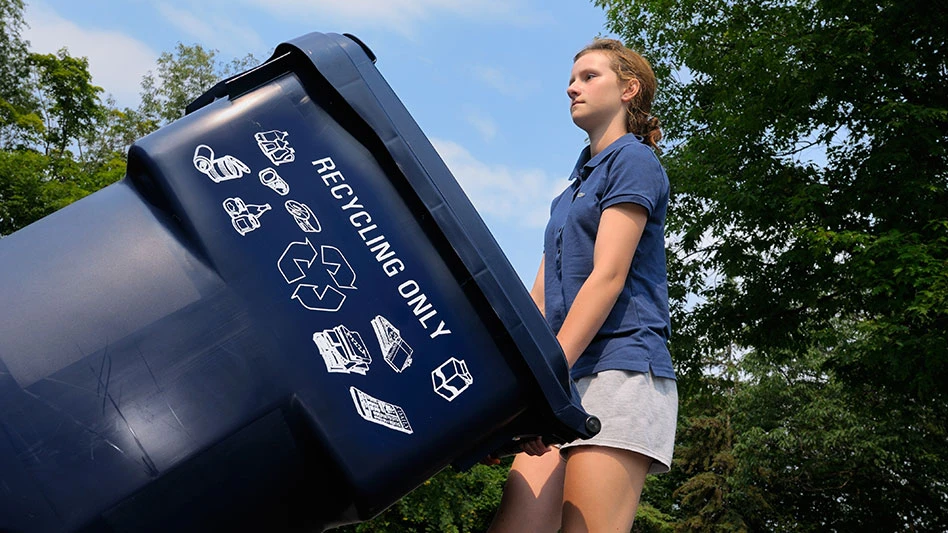
Reimar | stock.adobe.com
Akron Mayor Shammas Malik and nonprofit partner Keep Akron Beautiful (KAB) have reported that the city’s most recent recycling audit shows a contamination rate of 12.5 percent. Before the city and KAB began the Recycle Right campaign in 2019, Akron's contamination rate was 39.3 percent, which cost the city $205,031 annually. The lower contamination rate brings the city’s contamination costs down to zero and starts to create revenue for the city’s recycling program.
RELATED: Targeting contaminants
“Today’s announcement of our lowest-ever recycling contamination rate is a huge success for our city’s recycling program and for all of our residents who care about recycling in Akron,” Malik said at an Oct. 1 news conference. “Our partnership with Keep Akron Beautiful to conduct the Recycle Right campaign over the last five years, combined with our new glass drop-off recycling program and the efforts of our drivers and team to educate our residents, has successfully caused a drop in our contamination rate of nearly 27 percent. These numbers not only improve the quality of our recycling stream but also ensure that our program remains sustainable. I’m incredibly proud of this achievement for our city.”
The Recycle Right campaign is a communitywide initiative to improve the quality of curbside recycling by providing residents personalized and real-time curbside recycling education and feedback. The initiative mobilizes specially trained personnel from KAB to conduct curbside cart observations. Residents with nonrecyclables in their recycling carts receive informational “oops” tags on their carts with direct feedback designed to improve their recycling efforts. Recycling carts found to contain contaminants such as trash and other nonrecyclables are not collected. Instead, residents are given the opportunity to correct the mistake and return the cart to the curb the following week.
The program launched in June 2019 and ran until August 2019, with the city of Akron partnering with KAB; ReWorks, the Summit County/Akron solid waste management authority; the local material recovery facility (MRF) operated by Houston-based WM; the Ohio Environmental Protection Agency (EPA); and The Recycling Partnership, Washington, on its implementation.
The Ohio EPA selected KAB to receive a $66,000 grant to work with The Recycling Partnership on the initial program. The Recycling Partnership provided $150,000 in staff and resources for the program, and ReWorks supplied $20,000 in funds for project management.
After the first two rounds of the Recycle Right campaign, the city says its contamination rate dropped to 26.3 percent, which brought the related cost down to $38,038. Last year’s audit confirmed the continuing success of this program, showing the rate had dropped to 22.3 percent, meaning the city had nearly cut the contamination rate in half during the campaign.
In 2023, the city implemented a glass drop-off recycling program, allowing residents to recycle glass in a way that wouldn’t contaminate the recycling stream. The city recently announced that at least 80 tons of glass have been collected through that program.
The city and KAB launched another Recycle Right campaign this year that ran from June 10 through Aug. 9 with a goal of improving the contamination rate to less than 20 percent.
“Not only did we meet our goal of a less than 20 percent contamination rate, we blew that goal out of the water to only 12.5 percent,” CEO and Executive Director of Keep Akron Beautiful Jacqui Flaherty-Ricchiuti said at the news conference. “This is an outstanding accomplishment for the city and our organization, and we are so proud to see our efforts paying off in this way for Akron’s recycling program.”
Year to date, Akron has spent about $8,000 on recycling costs; however, clean recycling has generated a little more than $21,000 in revenue in the same time, which puts approximately $13,000 back into the recycling program, according to the city.
Latest from Recycling Today
- BMW Group, Encory launch 'direct recycling’ of batteries
- Loom Carbon, RTI International partner to scale textile recycling technology
- Goodwill Industries of West Michigan, American Glass Mosaics partner to divert glass from landfill
- CARI forms federal advocacy partnership
- Monthly packaging papers shipments down in November
- STEEL Act aims to enhance trade enforcement to prevent dumping of steel in the US
- San Francisco schools introduce compostable lunch trays
- Aduro graduates from Shell GameChanger program





